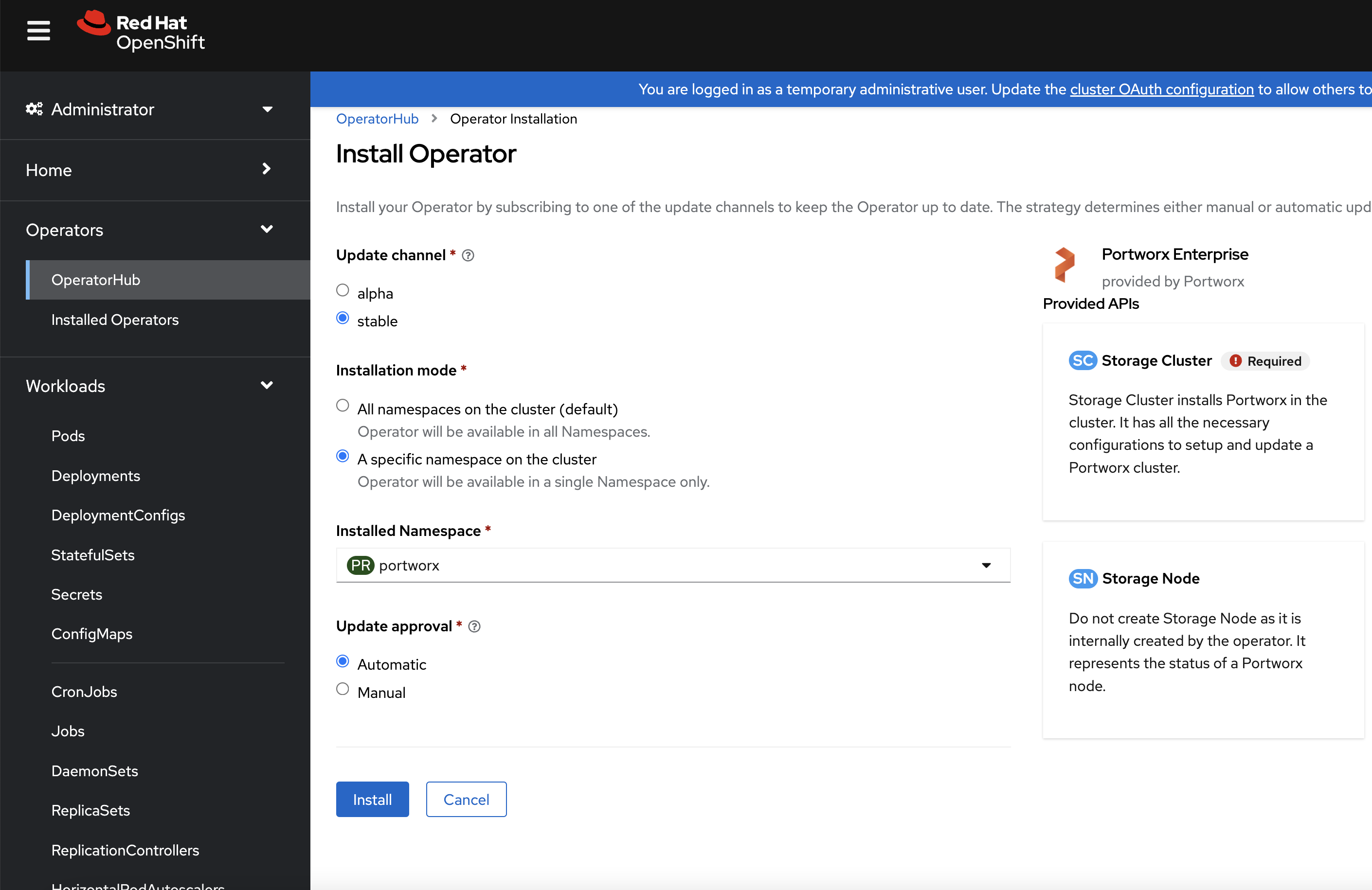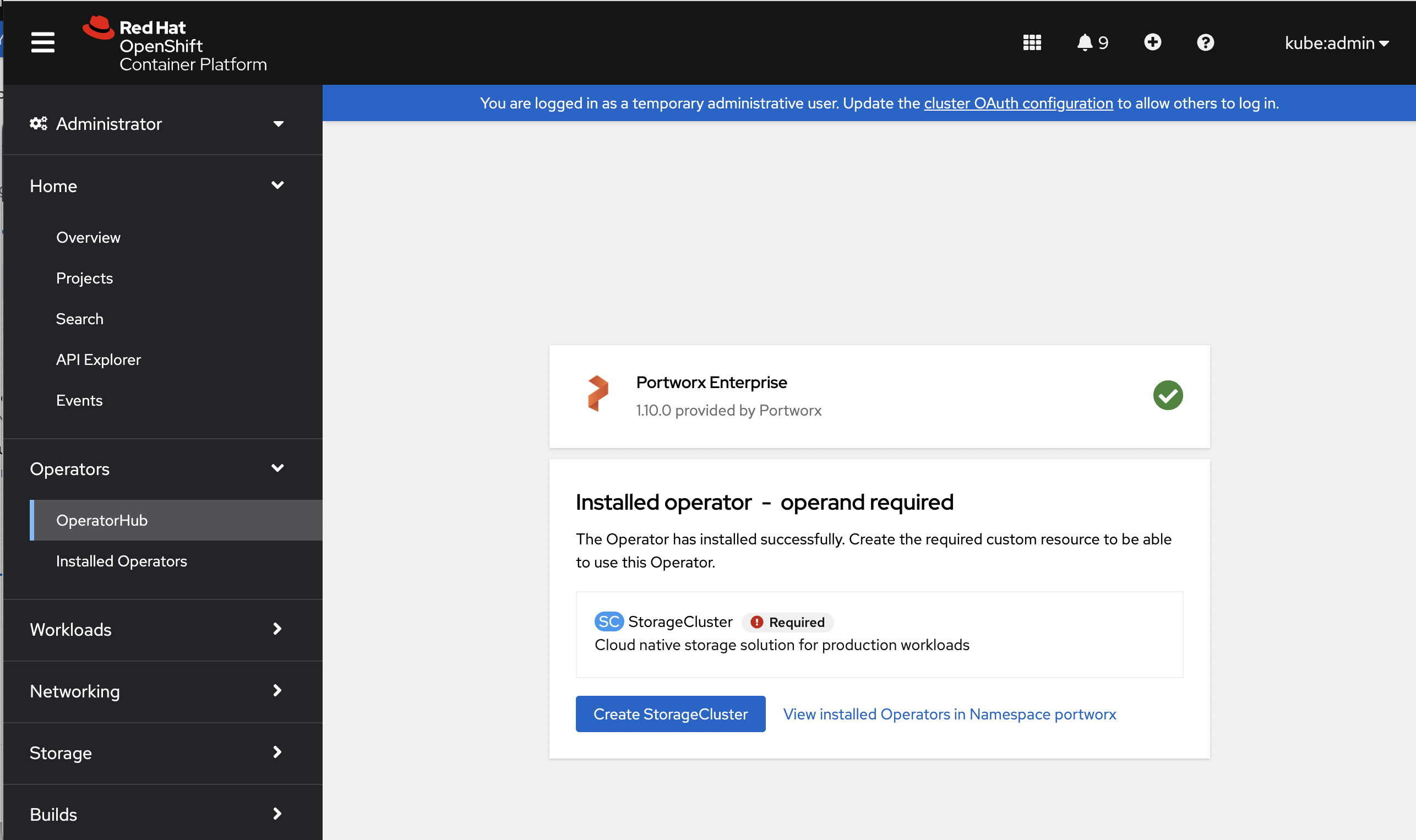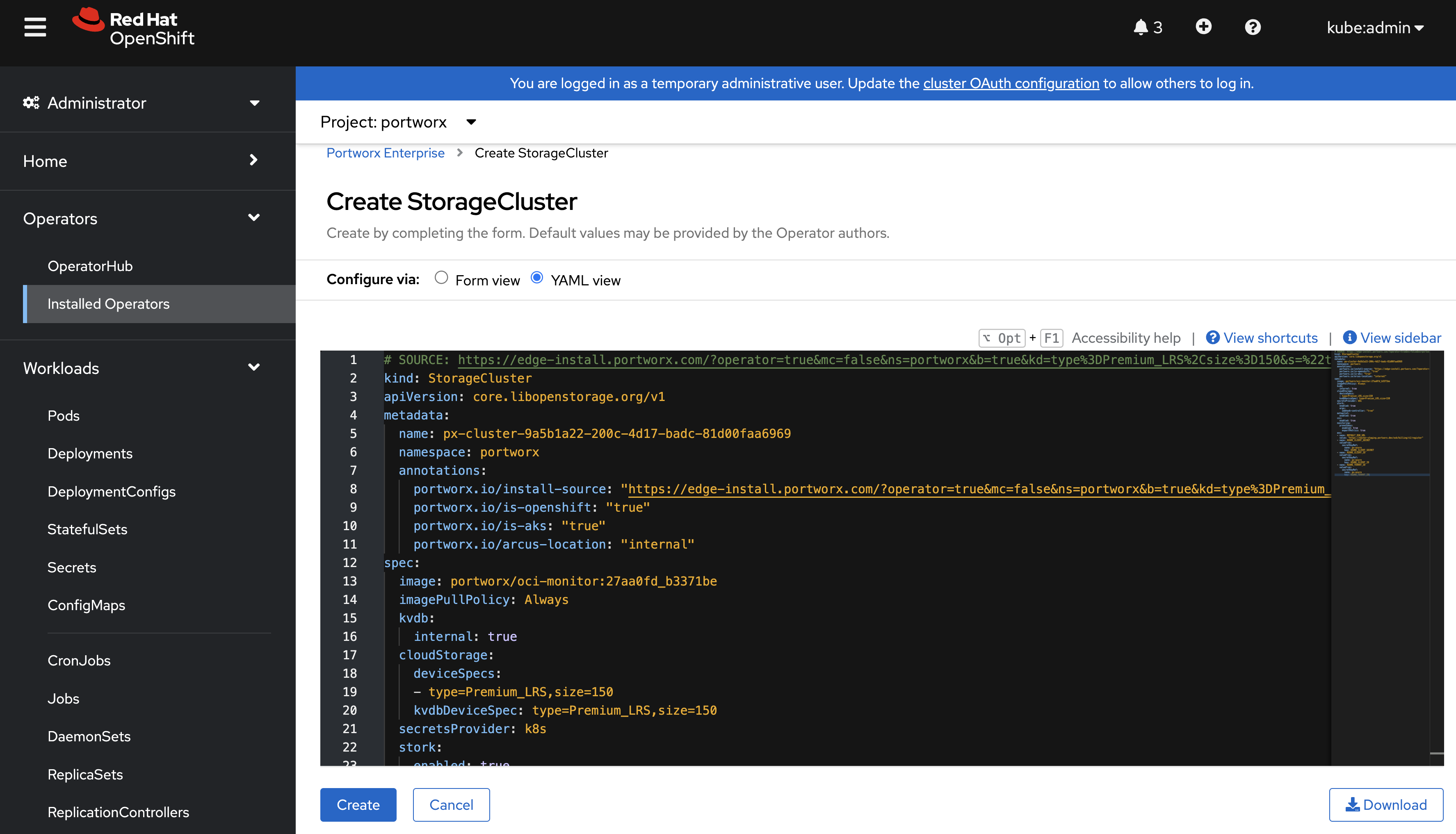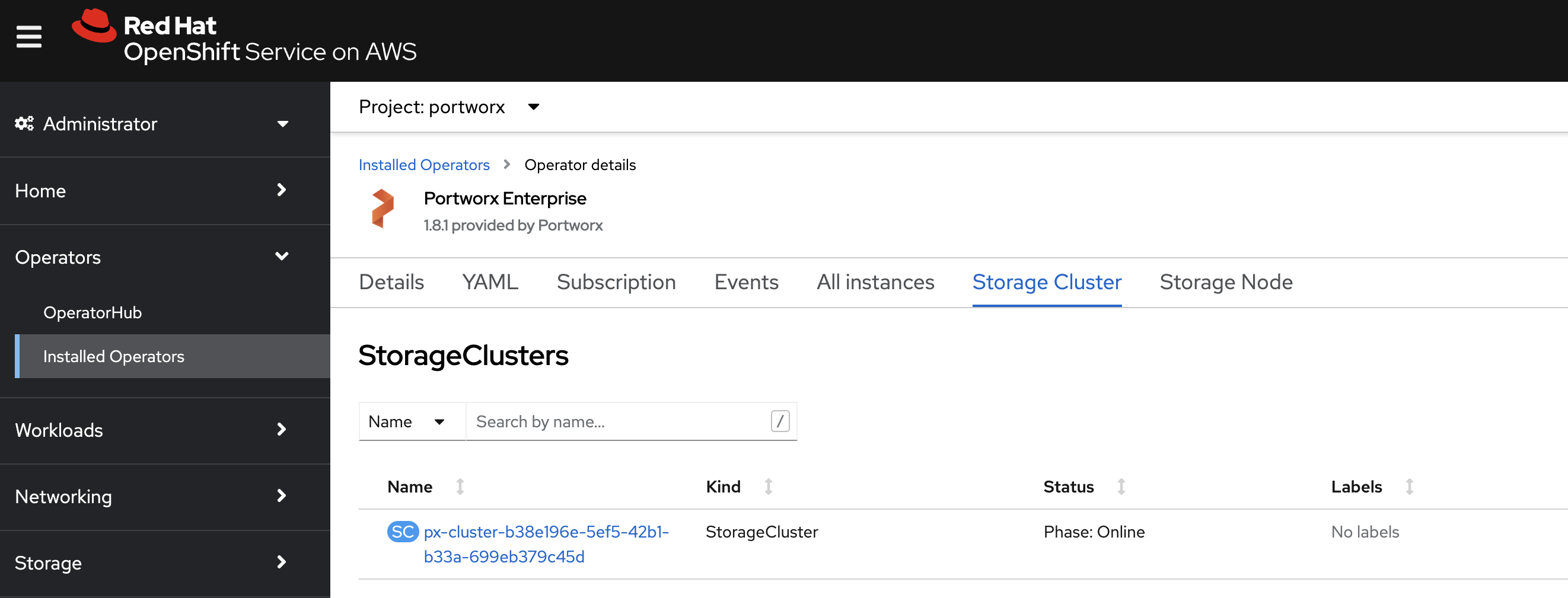Install Portworx on Azure Red Hat OpenShift
Prerequisites
Procedure
- Follow the cluster creation tutorial in the Microsoft Azure documentation, including the Get a Red Hat pull secret (optional) section.
- Follow the cluster connection tutorial in the Microsoft Azure documentation.
Find the ARO Service Principal
When deploying Portworx on Azure Red Hat Openshift (ARO), the virtual machines are created in a resource group with a Deny Assignment role that prevents any service principal from accessing virtual machines except the service principal created for the resource group. In this task, you identify the service principal for the resource group that has access, and configure it to pass on the credentials (Azure Client ID, Azure Client Secret, and Tenant ID) via the Portworx cluster spec. Portworx will fetch the px-azure secret object file to authenticate. Perform the following steps from your Azure Web UI:
Select Virtual Machines from the top navigation menu.
From the Virtual machines page, select the Resource Group associated with your cluster.
From the left panel on the Resource group page, select Access control (IAM).
On the Access control (IAM) subpage of your resource group, select Deny assignments from the toolbar in the center of the page, then select the link under the Name column (this will likely be an autogenerated string of letters and numbers).
This page shows that all principals are denied access, except for your resource group. Select your resource group's name.
From the application page, copy and save the following values:
- Name
- Application ID
- Object ID
You will use these to create the
px-azuresecret.From the home page, open the Azure Active Directory page (select All services to see the option). Select App registrations on the left pane, followed by All applications. In the search bar in the center of the page, paste the application name you saved in the previous step and press the enter key. Select the application link that shows in the results to open the next page.
From your application's page, select Certificates & secrets under Manage from the left pane.
From the Certificates & secrets page, select + New client secret to create a new secret. On the Add a client secret page, provide the description and expiry date of your secret and click Add.
You can see the newly created secret listed on the Client secret subpage. Copy and save the following values of your newly created secret:
- Value
- Secret ID
Create the px-azure secret with Service Principal credentials
Create a secret called px-azure to give Portworx access to Azure APIs by updating the following fields with the associated fields from the service principal you created in the previous section.
./oc create secret generic -n portworx px-azure\
--from-literal=AZURE_TENANT_ID=<tenant> \
--from-literal=AZURE_CLIENT_ID=<appId> \
--from-literal=AZURE_CLIENT_SECRET=<value>
secret/px-azure created
AZURE_TENANT_ID: Run theaz logincommand to get this valueAZURE_CLIENT_ID: Provide the Application ID associated with your cluster's resource group, which you saved in step 6 of the previous sectionAZURE_CLIENT_SECRET: Provide the Value of your secret, which you saved in the step 10 of the previous section
Create a monitoring ConfigMap
Newer OpenShift versions do not support the Portworx Prometheus deployment. As a result, you must enable monitoring for user-defined projects before installing the Portworx Operator. Use the instructions in this section to configure the OpenShift Prometheus deployment to monitor Portworx metrics.
To integrate OpenShift’s monitoring and alerting system with Portworx, create a cluster-monitoring-config ConfigMap in the openshift-monitoring namespace:
apiVersion: v1
kind: ConfigMap
metadata:
name: cluster-monitoring-config
namespace: openshift-monitoring
data:
config.yaml: |
enableUserWorkload: true
The enableUserWorkload parameter enables monitoring for user-defined projects in the OpenShift cluster. This creates a prometheus-operated service in the openshift-user-workload-monitoring namespace.
Generate Portworx spec
Navigate to Portworx Central and log in, or create an account.
Select Portworx Enterprise from the Product Catalog page.
On the Product Line page, choose any option depending on which license you intend to use, then click Continue to start the spec generator.
For Platform, choose Azure. Select Azure Red Hat OpenShift (ARO) for Distribution Name, then click Save Spec to generate the specs.
Install Portworx Operator using OpenShift UI
From your OpenShift UI, select OperatorHub in the left pane.
On the OperatorHub page, search for Portworx and select the Portworx Enterprise or Portworx Essentials card:

Click Install to install Portworx Operator:

Portworx Operator begins to install and takes you to the Install Operator page. On this page, select the A specific namespace on the cluster option for Installation mode. Choose the Create Project option from the Installed Namespace dropdown:

In the Create Project window, provide the name
portworxand click Create to create a namespace called portworx.Click Install to deploy Portworx Operator in the
portworxnamespace.
Deploy Portworx using OpenShift UI
Once the Operator is successfully installed, a Create StorageCluster button appears. Click the button to create a StorageCluster object:

On the Create StorageCluster page, choose YAML view to configure the StorageCluster object.
Copy and paste the Portworx spec that you generated in the Generate Portworx spec section into the text editor and click Create to deploy Portworx:

Verify that Portworx has deployed successfully by navigating to the Storage Cluster tab of the Installed Operators page. Once Portworx has fully deployed, the status will show as Online:

Verify your Portworx installation
Once you've installed Portworx, you can perform the following tasks to verify that Portworx has installed correctly.
Verify if all pods are running
Enter the following oc get pods command to list and filter the results for Portworx pods:
oc get pods -n portworx -o wide | grep -e portworx -e px
portworx-api-774c2 1/1 Running 0 2m55s 192.168.121.196 username-k8s1-node0 <none> <none>
portworx-api-t4lf9 1/1 Running 0 2m55s 192.168.121.99 username-k8s1-node1 <none> <none>
portworx-kvdb-94bpk 1/1 Running 0 4s 192.168.121.196 username-k8s1-node0 <none> <none>
portworx-operator-58967ddd6d-kmz6c 1/1 Running 0 4m1s 10.244.1.99 username-k8s1-node0 <none> <none>
prometheus-px-prometheus-0 2/2 Running 0 2m41s 10.244.1.105 username-k8s1-node0 <none> <none>
px-cluster-1c3edc42-4541-48fc-b173-3e9bf3cd834d-9gs79 2/2 Running 0 2m55s 192.168.121.196 username-k8s1-node0 <none> <none>
px-cluster-1c3edc42-4541-48fc-b173-3e9bf3cd834d-vpptx 1/2 Running 0 2m55s 192.168.121.99 username-k8s1-node1 <none> <none>
px-csi-ext-868fcb9fc6-54bmc 4/4 Running 0 3m5s 10.244.1.103 username-k8s1-node0 <none> <none>
px-csi-ext-868fcb9fc6-8tk79 4/4 Running 0 3m5s 10.244.1.102 username-k8s1-node0 <none> <none>
px-csi-ext-868fcb9fc6-vbqzk 4/4 Running 0 3m5s 10.244.3.107 username-k8s1-node1 <none> <none>
px-prometheus-operator-59b98b5897-9nwfv 1/1 Running 0 3m3s 10.244.1.104 username-k8s1-node0 <none> <none>
Note the name of one of your px-cluster pods. You'll run pxctl commands from these pods in following steps.
Verify Portworx cluster status
You can find the status of the Portworx cluster by running pxctl status commands from a pod. Enter the following oc exec command, specifying the pod name you retrieved in the previous section:
oc exec px-cluster-1c3edc42-4541-48fc-b173-3e9bf3cd834d-vpptx -n portworx -- /opt/pwx/bin/pxctl status
Defaulted container "portworx" out of: portworx, csi-node-driver-registrar
Status: PX is operational
Telemetry: Disabled or Unhealthy
Metering: Disabled or Unhealthy
License: Trial (expires in 31 days)
Node ID: 788bf810-57c4-4df1-9a5a-70c31d0f478e
IP: 192.168.121.99
Local Storage Pool: 1 pool
POOL IO_PRIORITY RAID_LEVEL USABLE USED STATUS ZONE REGION
0 HIGH raid0 3.0 TiB 10 GiB Online default default
Local Storage Devices: 3 devices
Device Path Media Type Size Last-Scan
0:1 /dev/vdb STORAGE_MEDIUM_MAGNETIC 1.0 TiB 14 Jul 22 22:03 UTC
0:2 /dev/vdc STORAGE_MEDIUM_MAGNETIC 1.0 TiB 14 Jul 22 22:03 UTC
0:3 /dev/vdd STORAGE_MEDIUM_MAGNETIC 1.0 TiB 14 Jul 22 22:03 UTC
* Internal kvdb on this node is sharing this storage device /dev/vdc to store its data.
total - 3.0 TiB
Cache Devices:
* No cache devices
Cluster Summary
Cluster ID: px-cluster-1c3edc42-4541-48fc-b173-3e9bf3cd834d
Cluster UUID: 33a82fe9-d93b-435b-943e-6f3fd5522eae
Scheduler: kubernetes
Nodes: 2 node(s) with storage (2 online)
IP ID SchedulerNodeName Auth StorageNode Used Capacity Status StorageStatus Version Kernel OS
192.168.121.196 f6d87392-81f4-459a-b3d4-fad8c65b8edc username-k8s1-node0 Disabled Yes 10 GiB 3.0 TiB Online Up 2.11.0-81faacc 3.10.0-1127.el7.x86_64 CentOS Linux 7 (Core)
192.168.121.99 788bf810-57c4-4df1-9a5a-70c31d0f478e username-k8s1-node1 Disabled Yes 10 GiB 3.0 TiB Online Up (This node) 2.11.0-81faacc 3.10.0-1127.el7.x86_64 CentOS Linux 7 (Core)
Global Storage Pool
Total Used : 20 GiB
Total Capacity : 6.0 TiB
The Portworx status will display PX is operational if your cluster is running as intended.
Verify pxctl cluster provision status
Find the storage cluster, the status should show as
Online:oc -n portworx get storageclusterNAME CLUSTER UUID STATUS VERSION AGE
px-cluster-1c3edc42-4541-48fc-b173-3e9bf3cd834d 33a82fe9-d93b-435b-943e-6f3fd5522eae Online 2.11.0 10mFind the storage nodes, the statuses should show as
Online:oc -n portworx get storagenodesNAME ID STATUS VERSION AGE
username-k8s1-node0 f6d87392-81f4-459a-b3d4-fad8c65b8edc Online 2.11.0-81faacc 11m
username-k8s1-node1 788bf810-57c4-4df1-9a5a-70c31d0f478e Online 2.11.0-81faacc 11mVerify the Portworx cluster provision status . Enter the following
oc execcommand, specifying the pod name you retrieved in the previous section:oc exec px-cluster-1c3edc42-4541-48fc-b173-3e9bf3cd834d-vpptx -n portworx -- /opt/pwx/bin/pxctl cluster provision-statusDefaulted container "portworx" out of: portworx, csi-node-driver-registrar
NODE NODE STATUS POOL POOL STATUS IO_PRIORITY SIZE AVAILABLE USED PROVISIONED ZONE REGION RACK
788bf810-57c4-4df1-9a5a-70c31d0f478e Up 0 ( 96e7ff01-fcff-4715-b61b-4d74ecc7e159 ) Online HIGH 3.0 TiB 3.0 TiB 10 GiB 0 B default default default
f6d87392-81f4-459a-b3d4-fad8c65b8edc Up 0 ( e06386e7-b769-4ce0-b674-97e4359e57c0 ) Online HIGH 3.0 TiB 3.0 TiB 10 GiB 0 B default default default
Create your first PVC
For your apps to use persistent volumes powered by Portworx, you must use a StorageClass that references Portworx as the provisioner. Portworx includes a number of default StorageClasses, which you can reference with PersistentVolumeClaims (PVCs) you create. For a more general overview of how storage works within Kubernetes, refer to the Persistent Volumes section of the Kubernetes documentation.
Perform the following steps to create a PVC:
Create a PVC referencing the
px-csi-dbdefault StorageClass and save the file:kind: PersistentVolumeClaim
apiVersion: v1
metadata:
name: px-check-pvc
spec:
storageClassName: px-csi-db
accessModes:
- ReadWriteOnce
resources:
requests:
storage: 2GiRun the
oc applycommand to create a PVC:oc apply -f <your-pvc-name>.yamlpersistentvolumeclaim/example-pvc created
Verify your StorageClass and PVC
Enter the following
oc get storageclasscommand, specify the name of the StorageClass you created in the steps above:oc get storageclass <your-storageclass-name>NAME PROVISIONER RECLAIMPOLICY VOLUMEBINDINGMODE ALLOWVOLUMEEXPANSION AGE
example-storageclass pxd.portworx.com Delete Immediate false 24mocwill return details about your storageClass if it was created correctly. Verify the configuration details appear as you intended.Enter the
oc get pvccommand, if this is the only StorageClass and PVC you've created, you should see only one entry in the output:oc get pvc <your-pvc-name>NAME STATUS VOLUME CAPACITY ACCESS MODES STORAGECLASS AGE
example-pvc Bound pvc-dce346e8-ff02-4dfb-935c-2377767c8ce0 2Gi RWO example-storageclass 3m7socwill return details about your PVC if it was created correctly. Verify the configuration details appear as you intended.